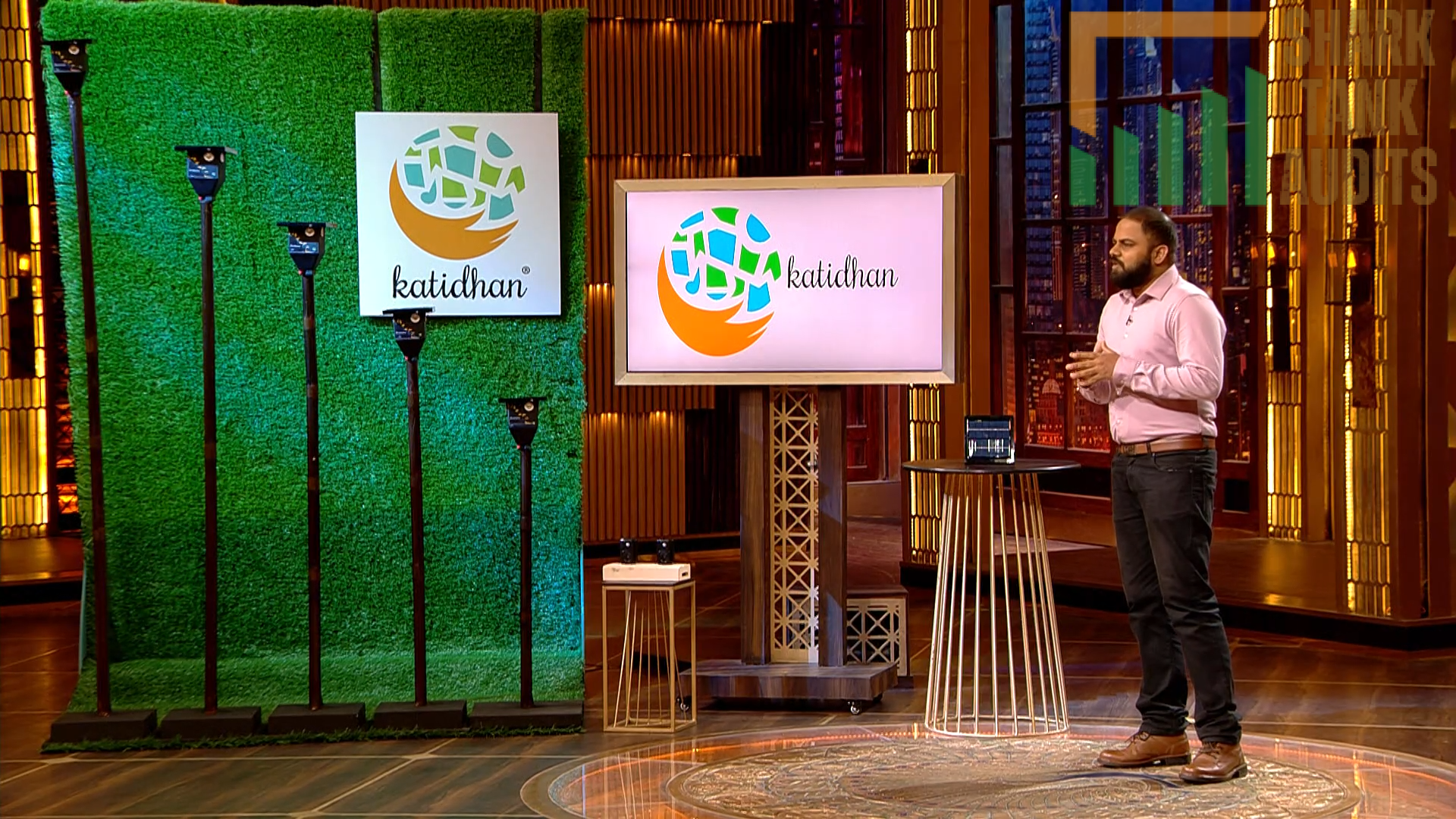Katidhan Shark Tank India Episode Review
Website Information:
- Website:- Katidhan
- Build on CMS WordPress
- Lack of SEO
- ORGANIC TRAFFIC:- 1 organic visitors per month
Founder:
- SR Ayan is the founder of Katidhan.
- S R Ayan is a technological artist known for his multifaceted approach, integrating design, engineering, and business principles to drive impactful projects with scalability.
- He focuses on striking a balance between disruptive and incremental innovation, emphasizing the execution process from conceptualization to the development of real-world products.
- Ayan’s passion for robotics drives his quest for collaboration, seeking teams to amplify the scalable impact of robotic technologies.
- Operating under his independent consulting brand “SRA,” Ayan showcases exceptional strategic design skills, collaborating with leading startups, corporates, innovation labs, and developmental organizations.
- Recognized as an innovator and sustainable technology entrepreneur, Ayan has earned leadership roles and numerous awards across various forums.
- Additionally, Ayan serves as a core member of a company dedicated to developing tech solutions addressing wildlife conflicts sustainably in the agricultural sector.

Product:
- Katidhan, a wildlife tracking and monitoring system, is the first pitch on Shark Tank India.
- Founder SR Ayan presents a solar-powered autonomous light deterrence solution that protects crops from wild animals.
- Interaction includes discussions on business acumen and market potential.
- The system activates at sunset and emits various light patterns throughout the night, scaring animals and preventing them from entering.
Pitch Details:
- Ayan seeks Rs 1.5 Crores for a 2.5% equity stake.
- Explains the concept, working mechanism, and effectiveness of the product.
- Highlights two product SKUs designed to deter animals and safeguard farmlands.
Financials and Impact:
- Discusses cost-effectiveness and savings for farmers.
- Shares revenue generated through the innovative product.
Sharks’ Response:
- Sharks express uncertainty due to the main buyers being government bodies and NGOs, citing high pricing.
- Ritesh offers Rs 75 Lakhs for 5% equity plus Rs 75 Lakhs debt at 10% interest for 3 years.
- Others refrain from making offers.
Deal Acceptance:
- Ayan accepts Ritesh’s offer, expressing gratitude for the unexpected deal and its favorable terms.
- Sharks acknowledge the uniqueness and potential of the product, agreeing that it’s a beneficial deal for both parties.
Pitch Highlights:
- Ayan explains the product’s functionality and its two variations for deterring different animals.
- He highlights cost savings for farmers who have used Katidhan.
- Revenue figures are presented, showcasing the product’s effectiveness.
Shark Tank India Air Date:
- Season 3, Episode 41, 18 March 2024
Shark Concerns:
- The Sharks are hesitant due to the product’s primary target market – government bodies and NGOs – which raises concerns about long sales cycles.
- The high price point for the technology is another concern.
Investment Offer:
- Ritesh offers a unique deal: Rs 75 lakh equity for 5% ownership + Rs 75 lakh debt at 10% interest for 3 years (interest is only paid when funds are withdrawn).
- Other Sharks acknowledge the offer’s value (15x valuation on a hardware product).
Outcome:
- Ayan accepts Ritesh’s offer, securing investment for Katidhan.

Katidhan Shark Tank Review Website Data
| Category | Description | Data/Source |
|---|---|---|
| Website Information | ||
| Platform | WordPress (CMS) | Katidhan Website |
| SEO | Needs Improvement (Low Organic Traffic) | – |
| Organic Traffic | 1 visitor/month | – |
| Founder | ||
| Name | SR Ayan | Katidhan Website |
| Expertise | Technological Artist (Design, Engineering, Business) | Katidhan Website |
| Focus | Scalable Solutions & Sustainable Projects | Katidhan Website |
| Experience | Startups, Corporates, Development Organizations | Katidhan Website |
| Recognition | Leader & Award-Winning Entrepreneur (Sustainable Tech) | Katidhan Website |
| Product | ||
| Name | Katidhan | Katidhan Website |
| Description | Solar-powered wildlife tracking & monitoring system with autonomous light deterrence | Katidhan Website |
| Function | Activates at sunset, emits light patterns to scare animals, protects crops | Katidhan Website |
| Variations | Two, for deterring different wildlife species | Katidhan Website |
| Business Potential in India | ||
| Factor 1 | Large Agricultural Sector (2nd Largest Producer) | – |
| Factor 2 | Wildlife Conflict (Crop Damage) | – |
| Factor 3 | Government Focus on Mitigation | – |
| Total Addressable Market (TAM) | ||
| Net Sown Area | 140 million hectares | Department of Agriculture & Cooperation (2023) |
| Market Penetration | 1% (targeting high-risk areas) | Assumption |
| Estimated Cost per Unit | Rs. 60,000/hectare | Assumption based on product variations & coverage |
| TAM Calculation | 140 million hectares * 1% * Rs. 60,000/hectare = Rs. 8,400 crore | |
| Ideal Target Audience | ||
| Demographics | Farmers in rural areas (high wildlife-human conflict regions) | – |
| Psychographics | Concerned about crop protection, open to sustainable solutions | – |
| Marketing Strategy | ||
| Content Marketing | Blog posts on wildlife damage, Katidhan benefits, farmer success stories | – |
| Educational Videos | Showcase product functionality and installation | – |
| Influencer Partnerships | Partner with agricultural influencers and NGOs | – |
| Digital Marketing Strategy | ||
| Social Media Ads | Targeted ads on Facebook & Instagram (location & interests) | – |
| Google Ads | Focus on keywords related to wildlife damage, crop protection, sustainable solutions | – |
| Banner Ads | Partner with agricultural websites and forums | – |
| Distribution Strategy | ||
| Direct Sales | Sell through company website & collaborate with agricultural equipment suppliers | – |
| Government & NGO Partnerships | Participate in tenders and collaborate with relevant NGOs | – |
| Pilot Programs | Implement programs with farmer cooperatives to demonstrate impact | – |
| Advantages | ||
| Sustainable Solution | Reduces wildlife-human conflict without harming animals | – |
| Proven Effectiveness | Light deterrence has a successful track record | – |
| Cost-Effective | Saves farmers money in the long run compared to traditional methods | – |
| Scalable Technology | Suitable for deployment across large agricultural areas | – |
| Challenges | ||
| High Initial Investment | Cost of the Katidhan unit might be a barrier for some farmers | – |
| Long Sales Cycles | Dealing with government/NGOs can involve lengthy procurement processes | – |
| Competition | Alternative wildlife deterrence methods already exist | – |
| Reasons for Success | ||
| Focus on Education | Providing farmers with clear information about Katidhan’s benefits | – |
| Partnerships | Collaboration with key stakeholders (NGOs, government agencies) | – |
| Data-Driven Approach | Collecting data on Katidhan’s effectiveness to showcase value | – |
| Flexible Pricing Models | Consider pay-as-you-save options or government subsidies | – |
| Mitigation Strategies | ||
| Financing Options | Partner with financial institutions to provide loan options for farmers | – |
| Freemium Model | Offer a basic version with limited functionality at a lower price point | – |
| Highlight Long-Term ROI | Emphasize cost savings through reduced crop damage | – |
| Invest in R&D | Continuously improve technology and explore cost-reduction opportunities | – |
| Future Business Roadmap | ||
| Product Line Expansion | Develop additional features like remote monitoring and animal identification | – |
Katidhan: Scaling Sustainable Wildlife Deterrence

Product:
- Katidhan is a solar-powered wildlife tracking and monitoring system with autonomous light deterrence.
- The system activates at sunset, emitting various light patterns to scare away animals and protect crops.
- Offers two product variations for deterring different wildlife species.
Business Potential in India:
- Large Agricultural Sector: India is the world’s second-largest producer of agricultural products.
- Wildlife Conflict: Crop damage due to wild animals is a significant issue for Indian farmers.
- Government Focus: The Indian government is actively seeking solutions to mitigate wildlife-human conflict.
Total Addressable Market (TAM):
- Considering 140 million hectares of net sown area in India (Source: Department of Agriculture & Cooperation, 2023) and assuming a 1% potential market penetration (targeting high-risk areas), the TAM is approximately Rs. 8,400 crore (140 million hectares * 1% * Rs. 60,000/hectare). (Note: Rs. 60,000/hectare represents an estimated cost per unit based on potential product variations and coverage area)
Ideal Target Audience:
- Demographics: Farmers in rural areas, particularly those in regions with high wildlife-human conflict.
- Psychographics: Individuals concerned about crop protection and open to sustainable solutions.
Marketing Strategy:
Content Marketing:
- Create informative blog posts and articles on wildlife damage, benefits of Katidhan, and success stories from farmers.
- Develop educational videos showcasing the product’s functionality and installation process.
- Partner with agricultural influencers and NGOs to promote Katidhan’s effectiveness.
Digital Marketing Strategy:
- Utilize targeted social media advertising (Facebook, Instagram) based on location and interests (farmers, rural audience).
- Run Google Ads campaigns focusing on keywords related to “wildlife damage,” “crop protection,” and “sustainable solutions.”
- Partner with agricultural websites and online forums to display Katidhan banner ads.
Distribution Strategy:
- Direct Sales: Sell Katidhan units through the company website and collaborate with agricultural equipment suppliers.
- Government & NGO Partnerships: Participate in government tenders and collaborate with NGOs focused on sustainable agriculture to reach a wider audience.
- Pilot Programs: Implement pilot programs with farmer cooperatives to demonstrate Katidhan’s impact and secure larger contracts.
Advantages:
- Sustainable Solution: Reduces wildlife-human conflict without harming animals.
- Proven Effectiveness: Light deterrence has a successful track record in protecting crops.
- Cost-Effective: Saves farmers money in the long run compared to traditional methods.
- Scalable Technology: Suitable for deployment across large agricultural areas.
Challenges:
- High Initial Investment: The cost of the Katidhan unit might be a barrier for some farmers.
- Long Sales Cycles: Dealing with government bodies and NGOs can involve lengthy procurement processes.
- Competition: Alternative wildlife deterrence methods already exist.
Reasons for Success:
- Focus on Education: Providing farmers with clear information about the benefits of Katidhan.
- Partnerships: Collaborating with key stakeholders like NGOs and government agencies.
- Data-Driven Approach: Collecting data on Katidhan’s effectiveness to showcase its value proposition.
- Flexible Pricing Models: Considering potential pay-as-you-save options or government subsidies.
Mitigation Strategies:
- Offer Financing Options: Partner with financial institutions to provide loan options for farmers.
- Develop a Freemium Model: Offer a basic version with limited functionality at a lower price point.
- Highlight Long-Term ROI: Emphasize the cost savings Katidhan offers through reduced crop damage.
- Invest in R&D: Continuously improve the technology and explore cost-reduction opportunities.
Future Business Roadmap:
- Product Line Expansion: Develop additional features for Katidhan, such as remote monitoring and animal identification.
- International Expansion: Enter markets with similar challenges of wildlife-human conflict.
- Data Analytics Platform: Build a platform that collects data on wildlife activity and helps predict animal movements.
Valuation Roadmap:
- Increase Brand Awareness: Implement the content and digital marketing strategies outlined above.
- Secure Large-Scale Deployments: Fulfill government contracts, pilot programs, and partnerships with NGOs to demonstrate successful implementation and impact.
- Demonstrate Revenue Growth: Focus on increasing sales through various channels and showcasing profitability.
- Highlight Social Impact: Quantify the positive environmental and social impact of Katidhan, such as reduced human-wildlife conflict and increased farmer income.
By implementing these strategies, Katidhan can address the concerns raised on Shark Tank India and position itself as a leading solution for sustainable wildlife deterrence in the agricultural sector. This will pave the way for future growth, potential acquisitions, and a significant increase in valuation.



